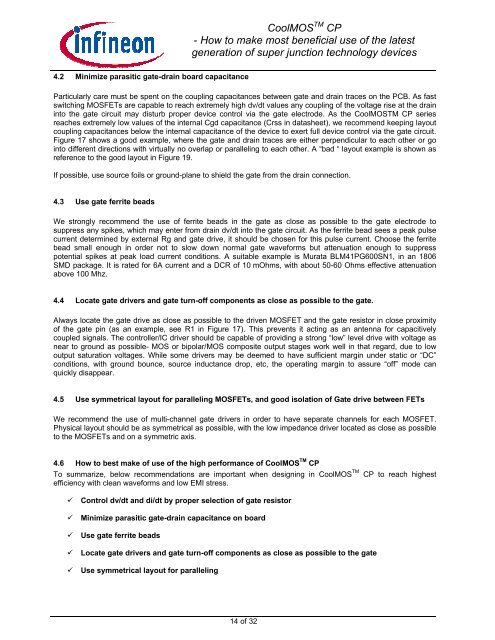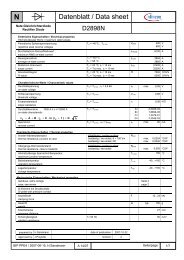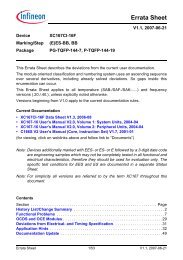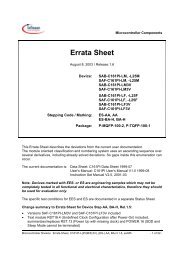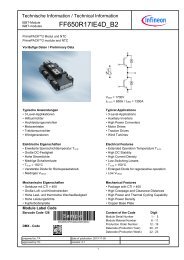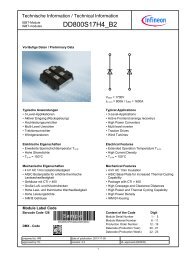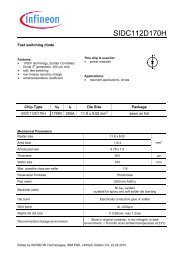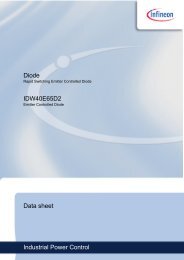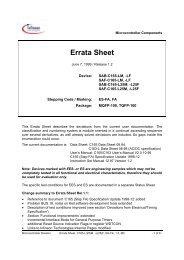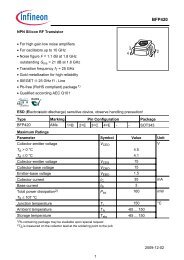Application Note CoolMOS™ CP - Infineon
Application Note CoolMOS™ CP - Infineon
Application Note CoolMOS™ CP - Infineon
You also want an ePaper? Increase the reach of your titles
YUMPU automatically turns print PDFs into web optimized ePapers that Google loves.
CoolMOS TM <strong>CP</strong><br />
- How to make most beneficial use of the latest<br />
generation of super junction technology devices<br />
4.2 Minimize parasitic gate-drain board capacitance<br />
Particularly care must be spent on the coupling capacitances between gate and drain traces on the PCB. As fast<br />
switching MOSFETs are capable to reach extremely high dv/dt values any coupling of the voltage rise at the drain<br />
into the gate circuit may disturb proper device control via the gate electrode. As the CoolMOSTM <strong>CP</strong> series<br />
reaches extremely low values of the internal Cgd capacitance (Crss in datasheet), we recommend keeping layout<br />
coupling capacitances below the internal capacitance of the device to exert full device control via the gate circuit.<br />
Figure 17 shows a good example, where the gate and drain traces are either perpendicular to each other or go<br />
into different directions with virtually no overlap or paralleling to each other. A “bad “ layout example is shown as<br />
reference to the good layout in Figure 19.<br />
If possible, use source foils or ground-plane to shield the gate from the drain connection.<br />
4.3 Use gate ferrite beads<br />
We strongly recommend the use of ferrite beads in the gate as close as possible to the gate electrode to<br />
suppress any spikes, which may enter from drain dv/dt into the gate circuit. As the ferrite bead sees a peak pulse<br />
current determined by external Rg and gate drive, it should be chosen for this pulse current. Choose the ferrite<br />
bead small enough in order not to slow down normal gate waveforms but attenuation enough to suppress<br />
potential spikes at peak load current conditions. A suitable example is Murata BLM41PG600SN1, in an 1806<br />
SMD package. It is rated for 6A current and a DCR of 10 mOhms, with about 50-60 Ohms effective attenuation<br />
above 100 Mhz.<br />
4.4 Locate gate drivers and gate turn-off components as close as possible to the gate.<br />
Always locate the gate drive as close as possible to the driven MOSFET and the gate resistor in close proximity<br />
of the gate pin (as an example, see R1 in Figure 17). This prevents it acting as an antenna for capacitively<br />
coupled signals. The controller/IC driver should be capable of providing a strong “low” level drive with voltage as<br />
near to ground as possible- MOS or bipolar/MOS composite output stages work well in that regard, due to low<br />
output saturation voltages. While some drivers may be deemed to have sufficient margin under static or “DC”<br />
conditions, with ground bounce, source inductance drop, etc, the operating margin to assure “off” mode can<br />
quickly disappear.<br />
4.5 Use symmetrical layout for paralleling MOSFETs, and good isolation of Gate drive between FETs<br />
We recommend the use of multi-channel gate drivers in order to have separate channels for each MOSFET.<br />
Physical layout should be as symmetrical as possible, with the low impedance driver located as close as possible<br />
to the MOSFETs and on a symmetric axis.<br />
4.6 How to best make of use of the high performance of CoolMOS TM <strong>CP</strong><br />
To summarize, below recommendations are important when designing in CoolMOS TM<br />
efficiency with clean waveforms and low EMI stress.<br />
<strong>CP</strong> to reach highest<br />
Control dv/dt and di/dt by proper selection of gate resistor<br />
Minimize parasitic gate-drain capacitance on board<br />
Use gate ferrite beads<br />
Locate gate drivers and gate turn-off components as close as possible to the gate<br />
Use symmetrical layout for paralleling<br />
14 of 32


